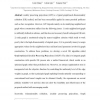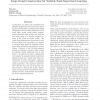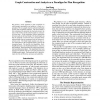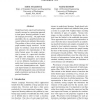115
click to vote
CVPR
2012
IEEE
13 years 3 months ago
2012
IEEE
The k-NN graph has played a central role in increasingly popular data-driven techniques for various learning and vision tasks; yet, finding an efficient and effective way to con...
106
Voted
IJON
2010
14 years 10 months ago
2010
Graph construction plays a key role on learning algorithms based on graph Laplacian. However, the traditional graph construction approaches of -neighborhood and k-nearest-neighbor...
131
click to vote
PR
2010
14 years 11 months ago
2010
Locality preserving projections (LPP) is a typical graph-based dimensionality reduction (DR) method, and has been successfully applied in many practical problems such as face recog...
115
Voted
ICML
2010
IEEE
15 years 1 months ago
2010
IEEE
In this paper, we address the scalability issue plaguing graph-based semi-supervised learning via a small number of anchor points which adequately cover the entire point cloud. Cr...
126
click to vote
ICML
2010
IEEE
15 years 1 months ago
2010
IEEE
Existing approaches to analyzing the asymptotics of graph Laplacians typically assume a well-behaved kernel function with smoothness assumptions. We remove the smoothness assumpti...
123
click to vote
AAAI
2000
15 years 2 months ago
2000
We present a novel approach to plan recognition in which graph construction and analysis is used as a paradigm. We use a graph structure called a Goal Graph for the plan recogniti...
106
Voted
NAACL
2007
15 years 2 months ago
2007
Graph-based semi-supervised learning has recently emerged as a promising approach to data-sparse learning problems in natural language processing. All graph-based algorithms rely ...
122
click to vote
LCPC
1999
Springer
15 years 5 months ago
1999
Springer
Since the C language imposes little restriction on the use of function pointers, the task of call graph construction for a C program is far more di cult than what the algorithms d...
ECAI
2000
Springer
15 years 5 months ago
2000
Springer
We present a novel approach to plan recognition based on a two-stage paradigm of graph construction and analysis. First, a graph structure called a Goal Graph is constructed to rep...
109
click to vote
PLDI
2009
ACM
15 years 7 months ago
2009
ACM
Symbolic analysis shows promise as a foundation for bug-finding, specification inference, verification, and test generation. This paper addresses demand-driven symbolic analysi...




